7233MED Global Health Systems: Comparing UK and Ethiopian Models
VerifiedAdded on 2023/03/23
|20
|5276
|28
Report
AI Summary
This report provides a comparative analysis of the healthcare systems in the UK and Ethiopia, utilizing the World Health Organization (WHO) framework, which includes key building blocks such as health service delivery, health workforce, health information, essential medicines, health financing, leadership, and governance. Data was collected through reviews of national health information systems, databases, health expenditure surveys, national health accounts, and administrative records. The findings indicate that the UK healthcare system outperforms Ethiopia's across all framework components, largely due to the UK's status as a developed nation. While the UK excels in service effectiveness, access, and efficiency, Ethiopia faces challenges in service utilization, workforce capacity, and resource management, despite recent improvements and expansion of healthcare facilities. The report also includes a reflection on the research process, highlighting key learnings and challenges encountered during the assessment.

Running head: COMPARING HEALTH SYSTEMS 1
Comparing Health Systems
Students Name
Institutional Affiliation
Comparing Health Systems
Students Name
Institutional Affiliation
Paraphrase This Document
Need a fresh take? Get an instant paraphrase of this document with our AI Paraphraser
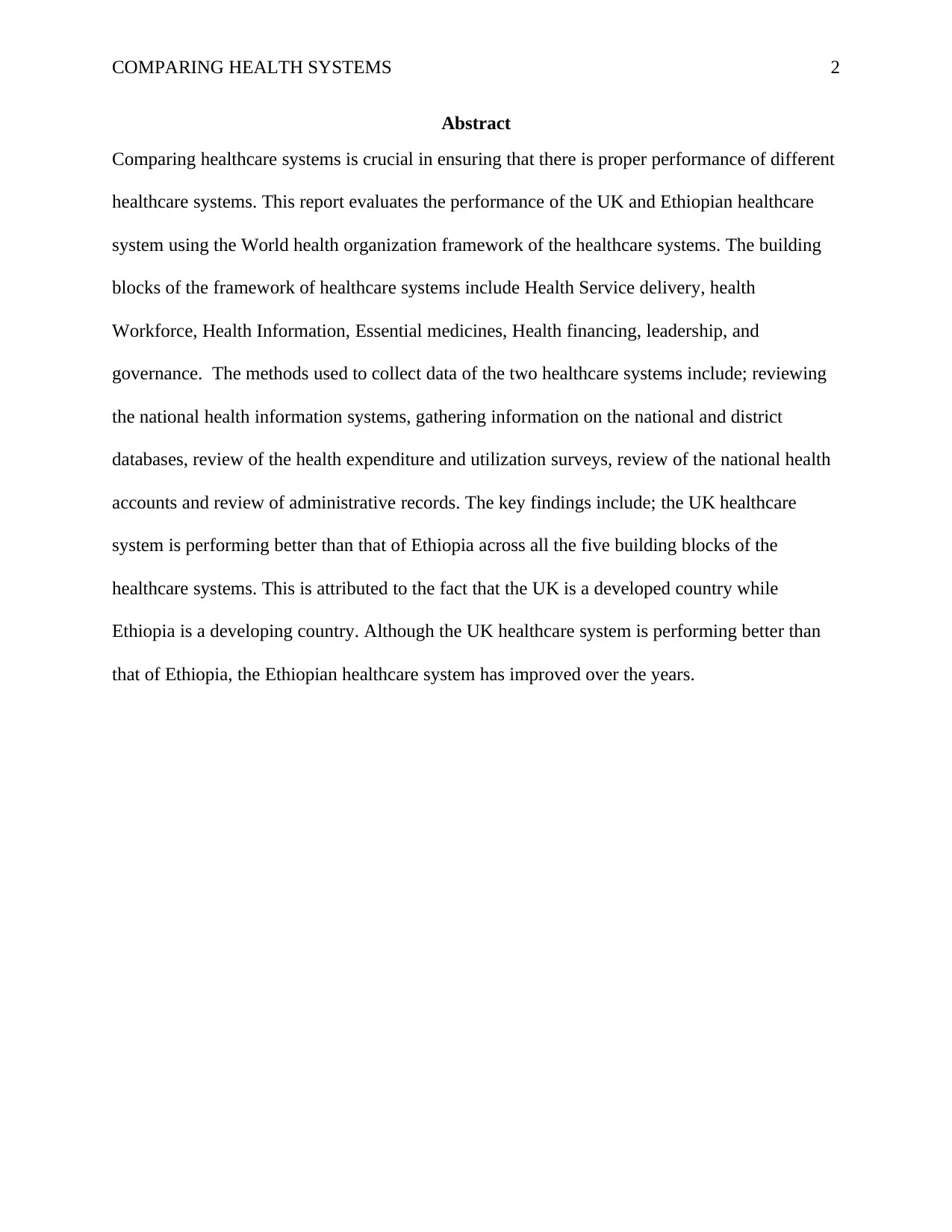
COMPARING HEALTH SYSTEMS 2
Abstract
Comparing healthcare systems is crucial in ensuring that there is proper performance of different
healthcare systems. This report evaluates the performance of the UK and Ethiopian healthcare
system using the World health organization framework of the healthcare systems. The building
blocks of the framework of healthcare systems include Health Service delivery, health
Workforce, Health Information, Essential medicines, Health financing, leadership, and
governance. The methods used to collect data of the two healthcare systems include; reviewing
the national health information systems, gathering information on the national and district
databases, review of the health expenditure and utilization surveys, review of the national health
accounts and review of administrative records. The key findings include; the UK healthcare
system is performing better than that of Ethiopia across all the five building blocks of the
healthcare systems. This is attributed to the fact that the UK is a developed country while
Ethiopia is a developing country. Although the UK healthcare system is performing better than
that of Ethiopia, the Ethiopian healthcare system has improved over the years.
Abstract
Comparing healthcare systems is crucial in ensuring that there is proper performance of different
healthcare systems. This report evaluates the performance of the UK and Ethiopian healthcare
system using the World health organization framework of the healthcare systems. The building
blocks of the framework of healthcare systems include Health Service delivery, health
Workforce, Health Information, Essential medicines, Health financing, leadership, and
governance. The methods used to collect data of the two healthcare systems include; reviewing
the national health information systems, gathering information on the national and district
databases, review of the health expenditure and utilization surveys, review of the national health
accounts and review of administrative records. The key findings include; the UK healthcare
system is performing better than that of Ethiopia across all the five building blocks of the
healthcare systems. This is attributed to the fact that the UK is a developed country while
Ethiopia is a developing country. Although the UK healthcare system is performing better than
that of Ethiopia, the Ethiopian healthcare system has improved over the years.
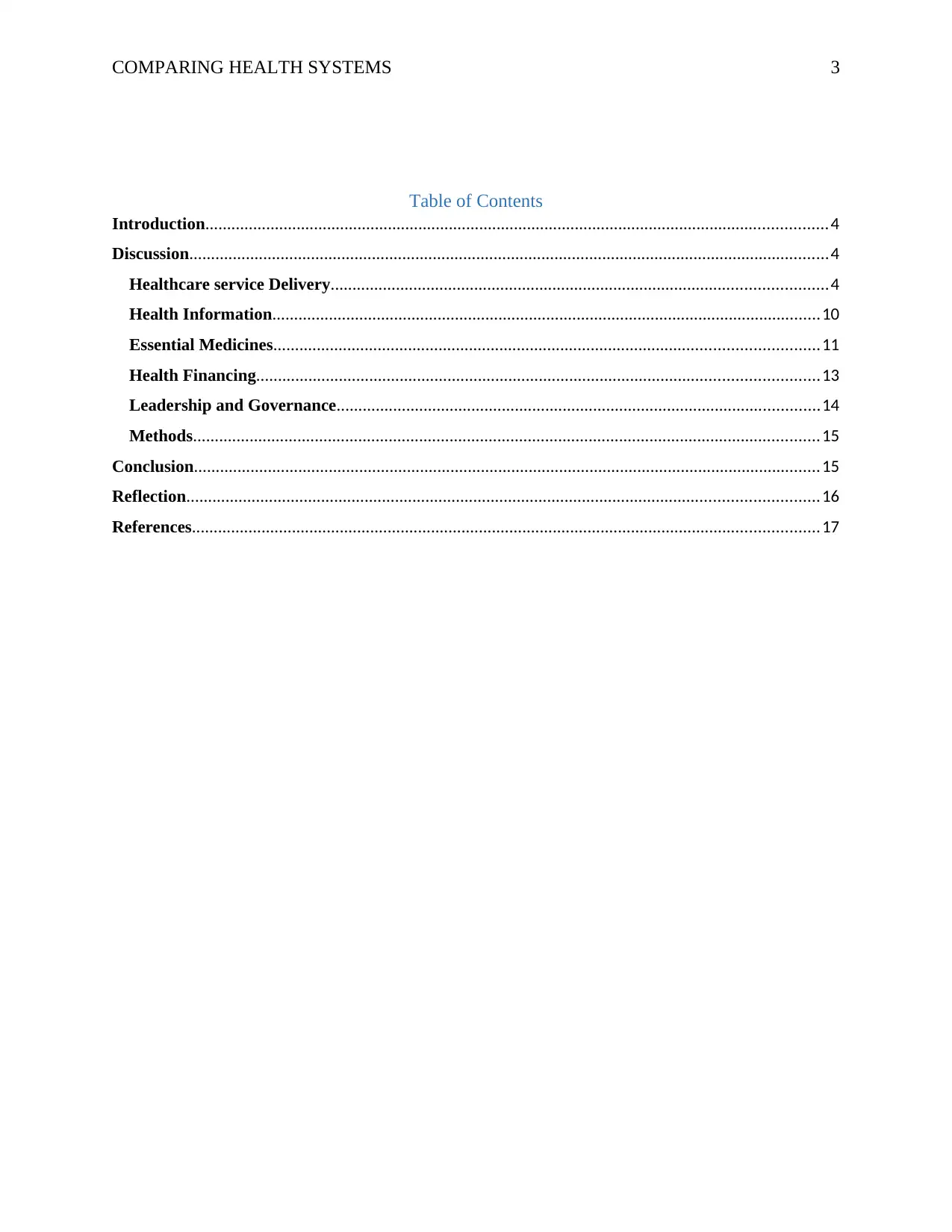
COMPARING HEALTH SYSTEMS 3
Table of Contents
Introduction...............................................................................................................................................4
Discussion...................................................................................................................................................4
Healthcare service Delivery..................................................................................................................4
Health Information..............................................................................................................................10
Essential Medicines.............................................................................................................................11
Health Financing.................................................................................................................................13
Leadership and Governance...............................................................................................................14
Methods................................................................................................................................................15
Conclusion................................................................................................................................................15
Reflection.................................................................................................................................................16
References................................................................................................................................................17
Table of Contents
Introduction...............................................................................................................................................4
Discussion...................................................................................................................................................4
Healthcare service Delivery..................................................................................................................4
Health Information..............................................................................................................................10
Essential Medicines.............................................................................................................................11
Health Financing.................................................................................................................................13
Leadership and Governance...............................................................................................................14
Methods................................................................................................................................................15
Conclusion................................................................................................................................................15
Reflection.................................................................................................................................................16
References................................................................................................................................................17
⊘ This is a preview!⊘
Do you want full access?
Subscribe today to unlock all pages.

Trusted by 1+ million students worldwide
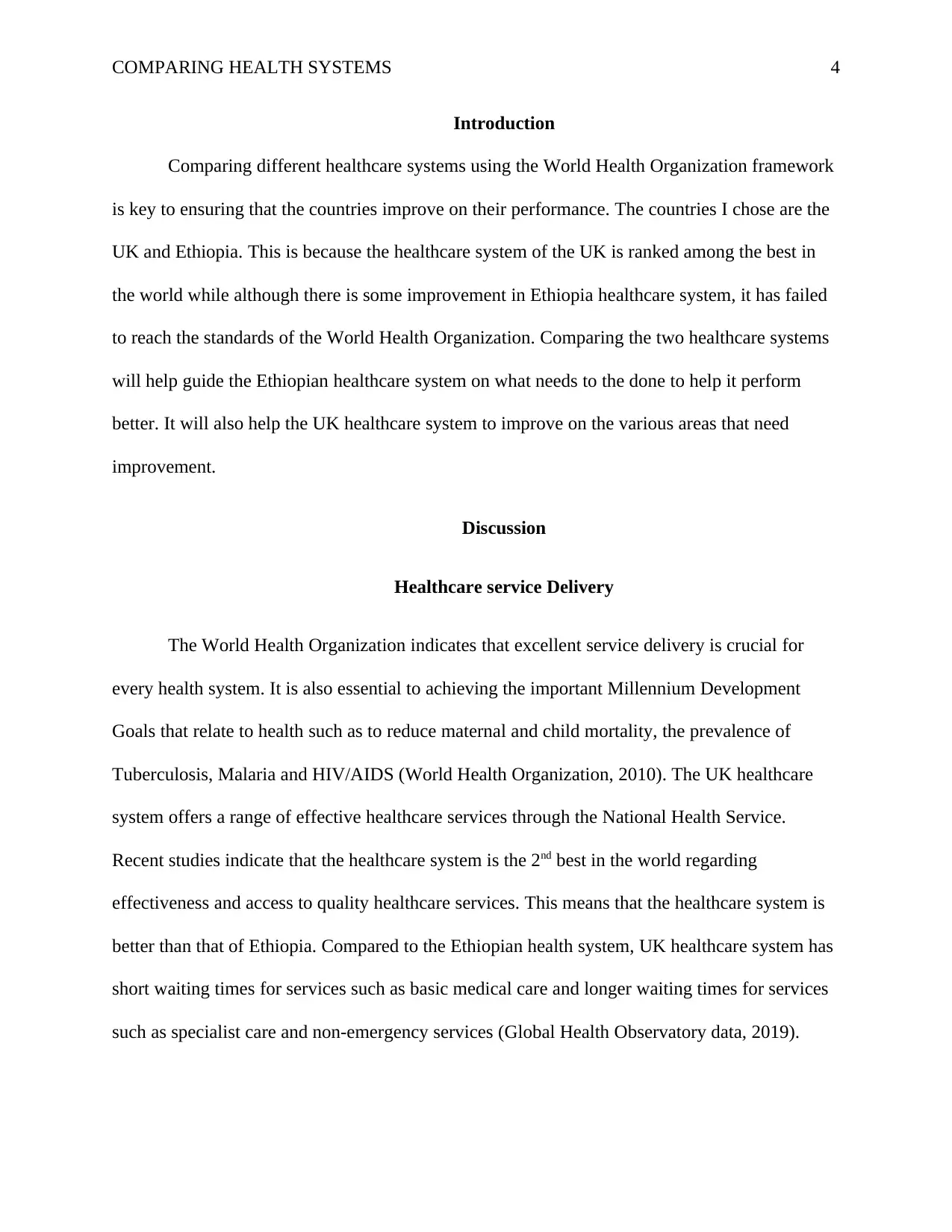
COMPARING HEALTH SYSTEMS 4
Introduction
Comparing different healthcare systems using the World Health Organization framework
is key to ensuring that the countries improve on their performance. The countries I chose are the
UK and Ethiopia. This is because the healthcare system of the UK is ranked among the best in
the world while although there is some improvement in Ethiopia healthcare system, it has failed
to reach the standards of the World Health Organization. Comparing the two healthcare systems
will help guide the Ethiopian healthcare system on what needs to the done to help it perform
better. It will also help the UK healthcare system to improve on the various areas that need
improvement.
Discussion
Healthcare service Delivery
The World Health Organization indicates that excellent service delivery is crucial for
every health system. It is also essential to achieving the important Millennium Development
Goals that relate to health such as to reduce maternal and child mortality, the prevalence of
Tuberculosis, Malaria and HIV/AIDS (World Health Organization, 2010). The UK healthcare
system offers a range of effective healthcare services through the National Health Service.
Recent studies indicate that the healthcare system is the 2nd best in the world regarding
effectiveness and access to quality healthcare services. This means that the healthcare system is
better than that of Ethiopia. Compared to the Ethiopian health system, UK healthcare system has
short waiting times for services such as basic medical care and longer waiting times for services
such as specialist care and non-emergency services (Global Health Observatory data, 2019).
Introduction
Comparing different healthcare systems using the World Health Organization framework
is key to ensuring that the countries improve on their performance. The countries I chose are the
UK and Ethiopia. This is because the healthcare system of the UK is ranked among the best in
the world while although there is some improvement in Ethiopia healthcare system, it has failed
to reach the standards of the World Health Organization. Comparing the two healthcare systems
will help guide the Ethiopian healthcare system on what needs to the done to help it perform
better. It will also help the UK healthcare system to improve on the various areas that need
improvement.
Discussion
Healthcare service Delivery
The World Health Organization indicates that excellent service delivery is crucial for
every health system. It is also essential to achieving the important Millennium Development
Goals that relate to health such as to reduce maternal and child mortality, the prevalence of
Tuberculosis, Malaria and HIV/AIDS (World Health Organization, 2010). The UK healthcare
system offers a range of effective healthcare services through the National Health Service.
Recent studies indicate that the healthcare system is the 2nd best in the world regarding
effectiveness and access to quality healthcare services. This means that the healthcare system is
better than that of Ethiopia. Compared to the Ethiopian health system, UK healthcare system has
short waiting times for services such as basic medical care and longer waiting times for services
such as specialist care and non-emergency services (Global Health Observatory data, 2019).
Paraphrase This Document
Need a fresh take? Get an instant paraphrase of this document with our AI Paraphraser
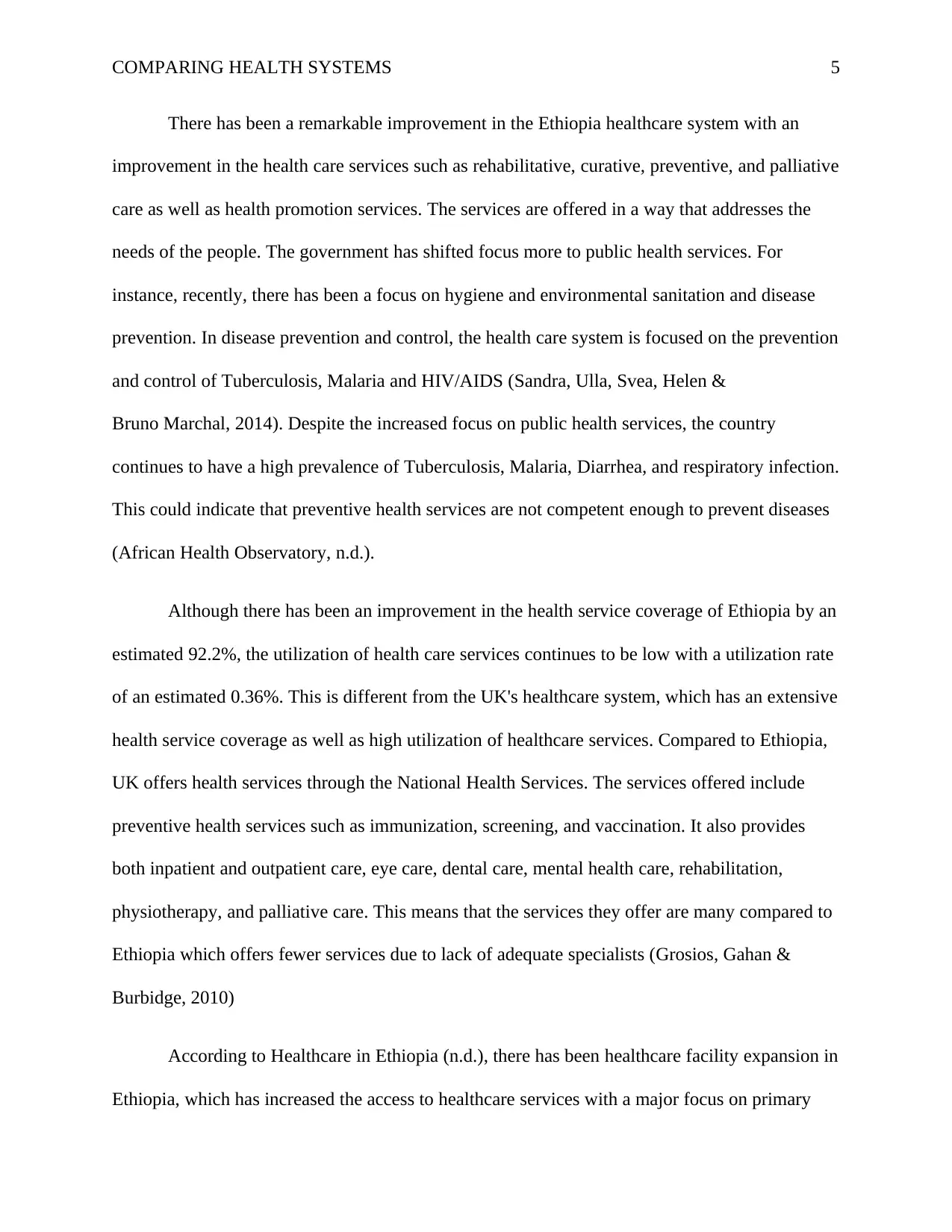
COMPARING HEALTH SYSTEMS 5
There has been a remarkable improvement in the Ethiopia healthcare system with an
improvement in the health care services such as rehabilitative, curative, preventive, and palliative
care as well as health promotion services. The services are offered in a way that addresses the
needs of the people. The government has shifted focus more to public health services. For
instance, recently, there has been a focus on hygiene and environmental sanitation and disease
prevention. In disease prevention and control, the health care system is focused on the prevention
and control of Tuberculosis, Malaria and HIV/AIDS (Sandra, Ulla, Svea, Helen &
Bruno Marchal, 2014). Despite the increased focus on public health services, the country
continues to have a high prevalence of Tuberculosis, Malaria, Diarrhea, and respiratory infection.
This could indicate that preventive health services are not competent enough to prevent diseases
(African Health Observatory, n.d.).
Although there has been an improvement in the health service coverage of Ethiopia by an
estimated 92.2%, the utilization of health care services continues to be low with a utilization rate
of an estimated 0.36%. This is different from the UK's healthcare system, which has an extensive
health service coverage as well as high utilization of healthcare services. Compared to Ethiopia,
UK offers health services through the National Health Services. The services offered include
preventive health services such as immunization, screening, and vaccination. It also provides
both inpatient and outpatient care, eye care, dental care, mental health care, rehabilitation,
physiotherapy, and palliative care. This means that the services they offer are many compared to
Ethiopia which offers fewer services due to lack of adequate specialists (Grosios, Gahan &
Burbidge, 2010)
According to Healthcare in Ethiopia (n.d.), there has been healthcare facility expansion in
Ethiopia, which has increased the access to healthcare services with a major focus on primary
There has been a remarkable improvement in the Ethiopia healthcare system with an
improvement in the health care services such as rehabilitative, curative, preventive, and palliative
care as well as health promotion services. The services are offered in a way that addresses the
needs of the people. The government has shifted focus more to public health services. For
instance, recently, there has been a focus on hygiene and environmental sanitation and disease
prevention. In disease prevention and control, the health care system is focused on the prevention
and control of Tuberculosis, Malaria and HIV/AIDS (Sandra, Ulla, Svea, Helen &
Bruno Marchal, 2014). Despite the increased focus on public health services, the country
continues to have a high prevalence of Tuberculosis, Malaria, Diarrhea, and respiratory infection.
This could indicate that preventive health services are not competent enough to prevent diseases
(African Health Observatory, n.d.).
Although there has been an improvement in the health service coverage of Ethiopia by an
estimated 92.2%, the utilization of health care services continues to be low with a utilization rate
of an estimated 0.36%. This is different from the UK's healthcare system, which has an extensive
health service coverage as well as high utilization of healthcare services. Compared to Ethiopia,
UK offers health services through the National Health Services. The services offered include
preventive health services such as immunization, screening, and vaccination. It also provides
both inpatient and outpatient care, eye care, dental care, mental health care, rehabilitation,
physiotherapy, and palliative care. This means that the services they offer are many compared to
Ethiopia which offers fewer services due to lack of adequate specialists (Grosios, Gahan &
Burbidge, 2010)
According to Healthcare in Ethiopia (n.d.), there has been healthcare facility expansion in
Ethiopia, which has increased the access to healthcare services with a major focus on primary
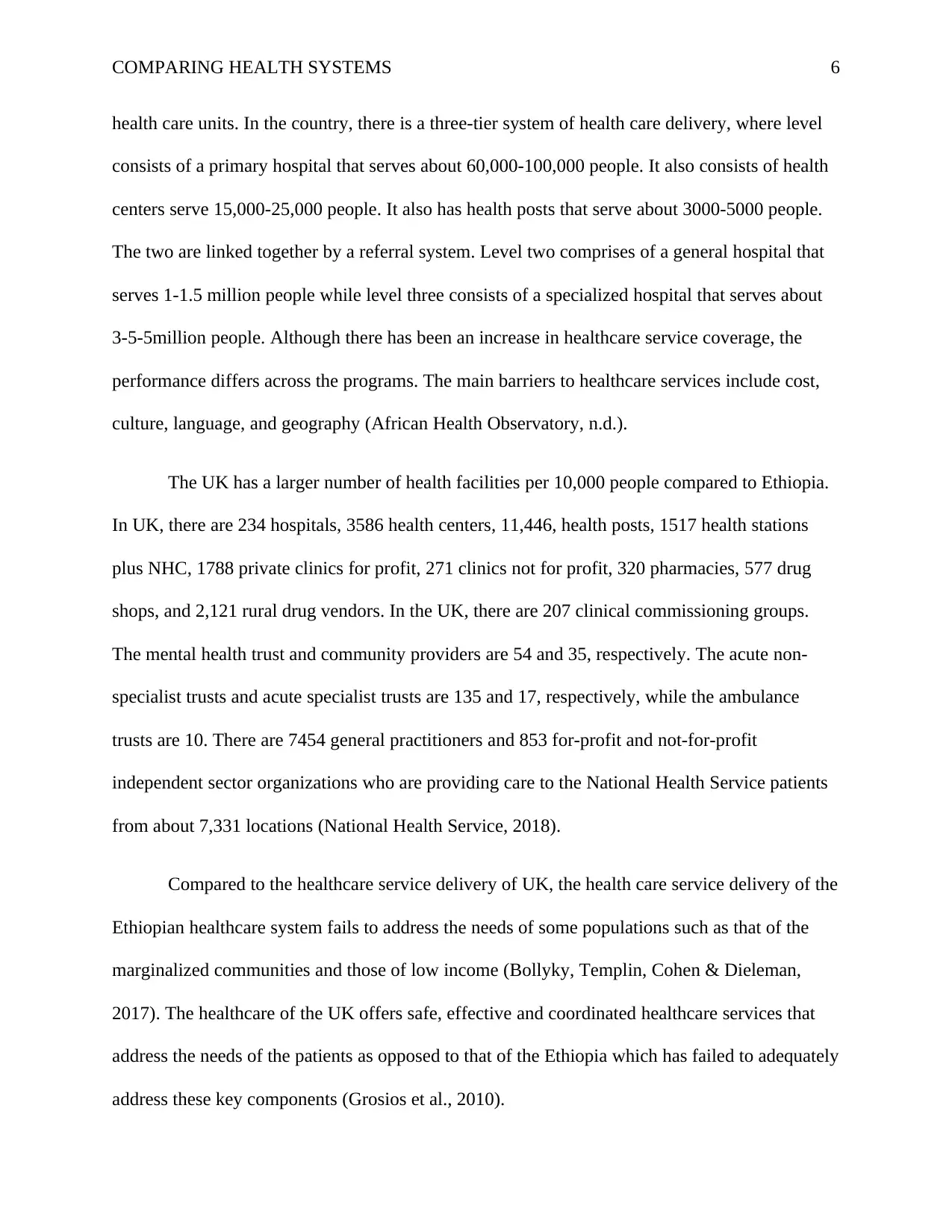
COMPARING HEALTH SYSTEMS 6
health care units. In the country, there is a three-tier system of health care delivery, where level
consists of a primary hospital that serves about 60,000-100,000 people. It also consists of health
centers serve 15,000-25,000 people. It also has health posts that serve about 3000-5000 people.
The two are linked together by a referral system. Level two comprises of a general hospital that
serves 1-1.5 million people while level three consists of a specialized hospital that serves about
3-5-5million people. Although there has been an increase in healthcare service coverage, the
performance differs across the programs. The main barriers to healthcare services include cost,
culture, language, and geography (African Health Observatory, n.d.).
The UK has a larger number of health facilities per 10,000 people compared to Ethiopia.
In UK, there are 234 hospitals, 3586 health centers, 11,446, health posts, 1517 health stations
plus NHC, 1788 private clinics for profit, 271 clinics not for profit, 320 pharmacies, 577 drug
shops, and 2,121 rural drug vendors. In the UK, there are 207 clinical commissioning groups.
The mental health trust and community providers are 54 and 35, respectively. The acute non-
specialist trusts and acute specialist trusts are 135 and 17, respectively, while the ambulance
trusts are 10. There are 7454 general practitioners and 853 for-profit and not-for-profit
independent sector organizations who are providing care to the National Health Service patients
from about 7,331 locations (National Health Service, 2018).
Compared to the healthcare service delivery of UK, the health care service delivery of the
Ethiopian healthcare system fails to address the needs of some populations such as that of the
marginalized communities and those of low income (Bollyky, Templin, Cohen & Dieleman,
2017). The healthcare of the UK offers safe, effective and coordinated healthcare services that
address the needs of the patients as opposed to that of the Ethiopia which has failed to adequately
address these key components (Grosios et al., 2010).
health care units. In the country, there is a three-tier system of health care delivery, where level
consists of a primary hospital that serves about 60,000-100,000 people. It also consists of health
centers serve 15,000-25,000 people. It also has health posts that serve about 3000-5000 people.
The two are linked together by a referral system. Level two comprises of a general hospital that
serves 1-1.5 million people while level three consists of a specialized hospital that serves about
3-5-5million people. Although there has been an increase in healthcare service coverage, the
performance differs across the programs. The main barriers to healthcare services include cost,
culture, language, and geography (African Health Observatory, n.d.).
The UK has a larger number of health facilities per 10,000 people compared to Ethiopia.
In UK, there are 234 hospitals, 3586 health centers, 11,446, health posts, 1517 health stations
plus NHC, 1788 private clinics for profit, 271 clinics not for profit, 320 pharmacies, 577 drug
shops, and 2,121 rural drug vendors. In the UK, there are 207 clinical commissioning groups.
The mental health trust and community providers are 54 and 35, respectively. The acute non-
specialist trusts and acute specialist trusts are 135 and 17, respectively, while the ambulance
trusts are 10. There are 7454 general practitioners and 853 for-profit and not-for-profit
independent sector organizations who are providing care to the National Health Service patients
from about 7,331 locations (National Health Service, 2018).
Compared to the healthcare service delivery of UK, the health care service delivery of the
Ethiopian healthcare system fails to address the needs of some populations such as that of the
marginalized communities and those of low income (Bollyky, Templin, Cohen & Dieleman,
2017). The healthcare of the UK offers safe, effective and coordinated healthcare services that
address the needs of the patients as opposed to that of the Ethiopia which has failed to adequately
address these key components (Grosios et al., 2010).
⊘ This is a preview!⊘
Do you want full access?
Subscribe today to unlock all pages.

Trusted by 1+ million students worldwide
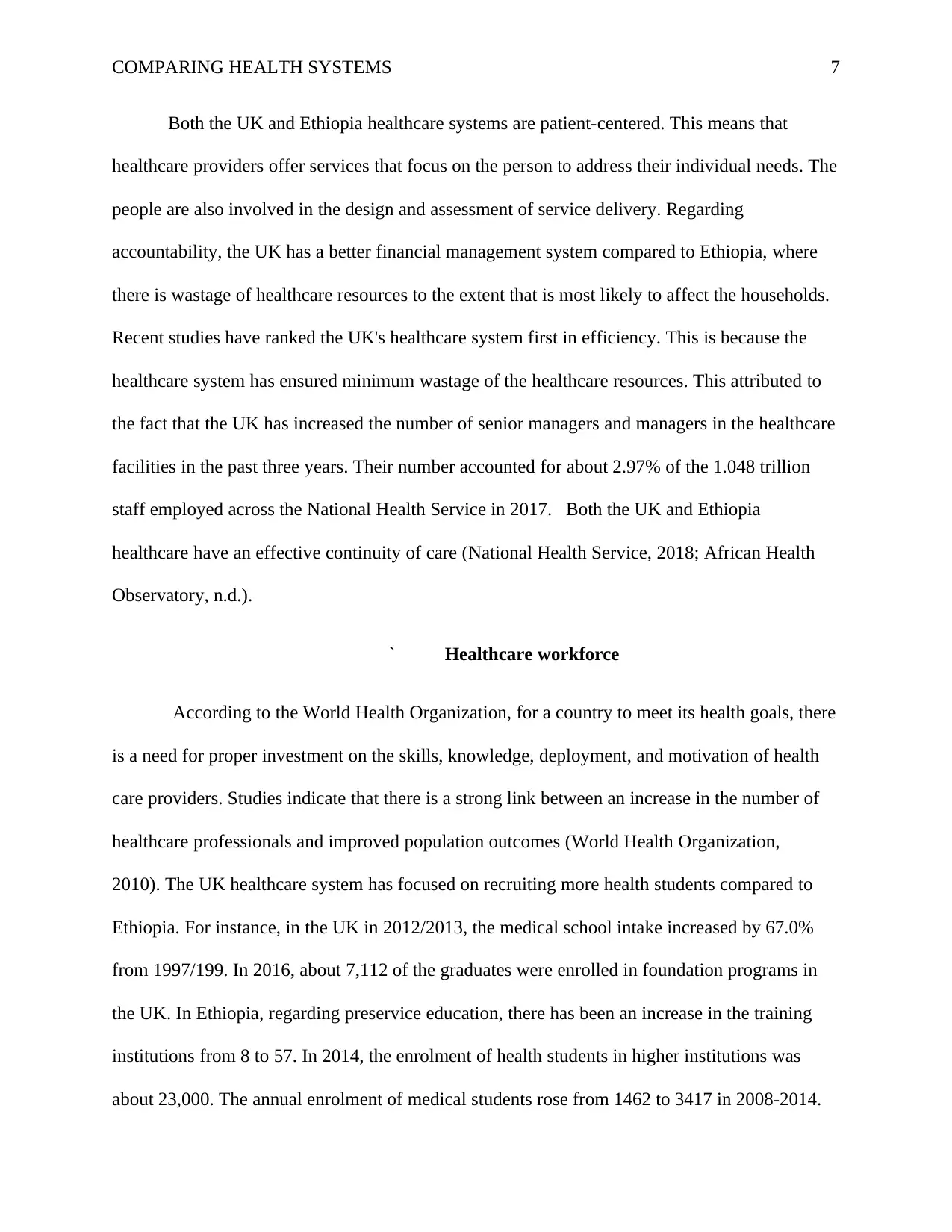
COMPARING HEALTH SYSTEMS 7
Both the UK and Ethiopia healthcare systems are patient-centered. This means that
healthcare providers offer services that focus on the person to address their individual needs. The
people are also involved in the design and assessment of service delivery. Regarding
accountability, the UK has a better financial management system compared to Ethiopia, where
there is wastage of healthcare resources to the extent that is most likely to affect the households.
Recent studies have ranked the UK's healthcare system first in efficiency. This is because the
healthcare system has ensured minimum wastage of the healthcare resources. This attributed to
the fact that the UK has increased the number of senior managers and managers in the healthcare
facilities in the past three years. Their number accounted for about 2.97% of the 1.048 trillion
staff employed across the National Health Service in 2017. Both the UK and Ethiopia
healthcare have an effective continuity of care (National Health Service, 2018; African Health
Observatory, n.d.).
` Healthcare workforce
According to the World Health Organization, for a country to meet its health goals, there
is a need for proper investment on the skills, knowledge, deployment, and motivation of health
care providers. Studies indicate that there is a strong link between an increase in the number of
healthcare professionals and improved population outcomes (World Health Organization,
2010). The UK healthcare system has focused on recruiting more health students compared to
Ethiopia. For instance, in the UK in 2012/2013, the medical school intake increased by 67.0%
from 1997/199. In 2016, about 7,112 of the graduates were enrolled in foundation programs in
the UK. In Ethiopia, regarding preservice education, there has been an increase in the training
institutions from 8 to 57. In 2014, the enrolment of health students in higher institutions was
about 23,000. The annual enrolment of medical students rose from 1462 to 3417 in 2008-2014.
Both the UK and Ethiopia healthcare systems are patient-centered. This means that
healthcare providers offer services that focus on the person to address their individual needs. The
people are also involved in the design and assessment of service delivery. Regarding
accountability, the UK has a better financial management system compared to Ethiopia, where
there is wastage of healthcare resources to the extent that is most likely to affect the households.
Recent studies have ranked the UK's healthcare system first in efficiency. This is because the
healthcare system has ensured minimum wastage of the healthcare resources. This attributed to
the fact that the UK has increased the number of senior managers and managers in the healthcare
facilities in the past three years. Their number accounted for about 2.97% of the 1.048 trillion
staff employed across the National Health Service in 2017. Both the UK and Ethiopia
healthcare have an effective continuity of care (National Health Service, 2018; African Health
Observatory, n.d.).
` Healthcare workforce
According to the World Health Organization, for a country to meet its health goals, there
is a need for proper investment on the skills, knowledge, deployment, and motivation of health
care providers. Studies indicate that there is a strong link between an increase in the number of
healthcare professionals and improved population outcomes (World Health Organization,
2010). The UK healthcare system has focused on recruiting more health students compared to
Ethiopia. For instance, in the UK in 2012/2013, the medical school intake increased by 67.0%
from 1997/199. In 2016, about 7,112 of the graduates were enrolled in foundation programs in
the UK. In Ethiopia, regarding preservice education, there has been an increase in the training
institutions from 8 to 57. In 2014, the enrolment of health students in higher institutions was
about 23,000. The annual enrolment of medical students rose from 1462 to 3417 in 2008-2014.
Paraphrase This Document
Need a fresh take? Get an instant paraphrase of this document with our AI Paraphraser
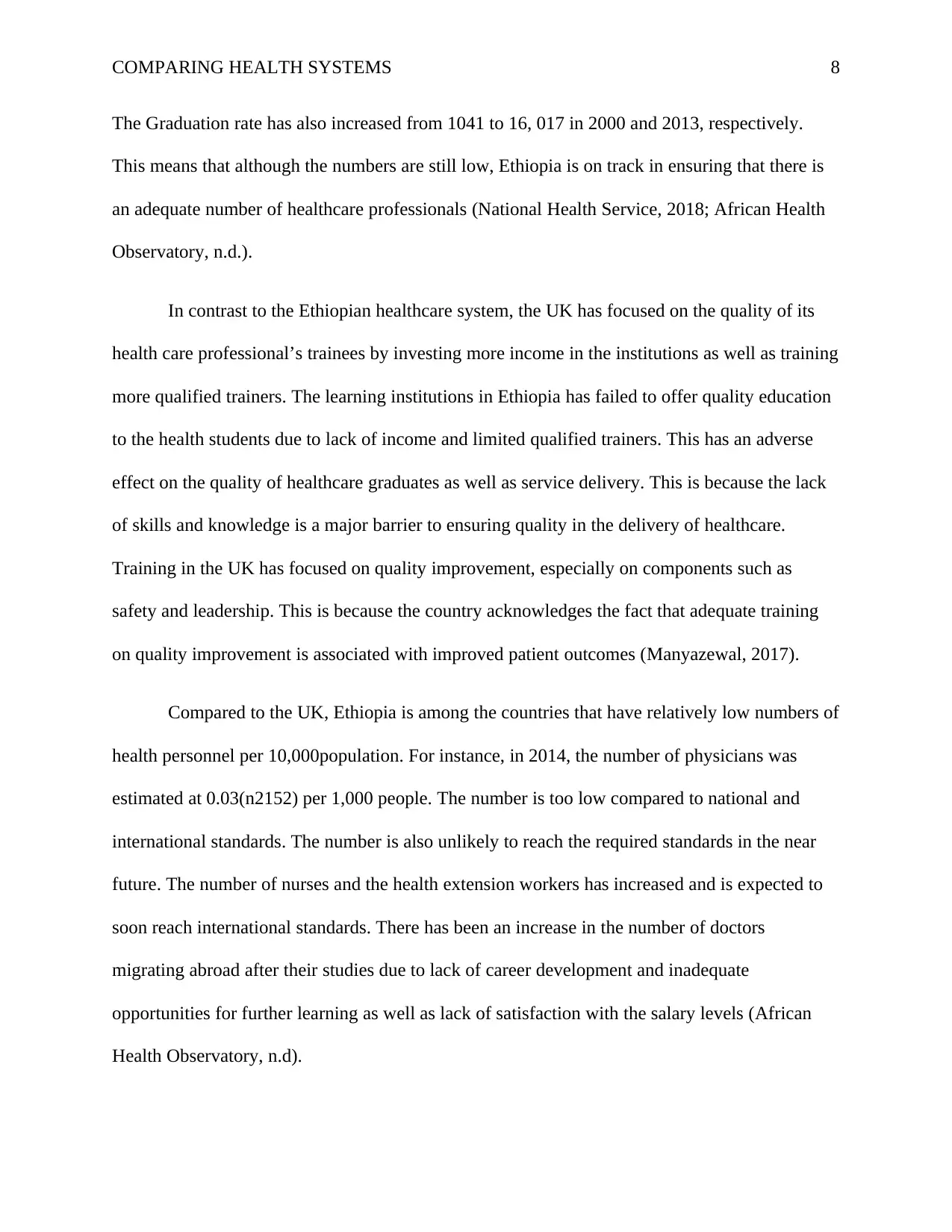
COMPARING HEALTH SYSTEMS 8
The Graduation rate has also increased from 1041 to 16, 017 in 2000 and 2013, respectively.
This means that although the numbers are still low, Ethiopia is on track in ensuring that there is
an adequate number of healthcare professionals (National Health Service, 2018; African Health
Observatory, n.d.).
In contrast to the Ethiopian healthcare system, the UK has focused on the quality of its
health care professional’s trainees by investing more income in the institutions as well as training
more qualified trainers. The learning institutions in Ethiopia has failed to offer quality education
to the health students due to lack of income and limited qualified trainers. This has an adverse
effect on the quality of healthcare graduates as well as service delivery. This is because the lack
of skills and knowledge is a major barrier to ensuring quality in the delivery of healthcare.
Training in the UK has focused on quality improvement, especially on components such as
safety and leadership. This is because the country acknowledges the fact that adequate training
on quality improvement is associated with improved patient outcomes (Manyazewal, 2017).
Compared to the UK, Ethiopia is among the countries that have relatively low numbers of
health personnel per 10,000population. For instance, in 2014, the number of physicians was
estimated at 0.03(n2152) per 1,000 people. The number is too low compared to national and
international standards. The number is also unlikely to reach the required standards in the near
future. The number of nurses and the health extension workers has increased and is expected to
soon reach international standards. There has been an increase in the number of doctors
migrating abroad after their studies due to lack of career development and inadequate
opportunities for further learning as well as lack of satisfaction with the salary levels (African
Health Observatory, n.d).
The Graduation rate has also increased from 1041 to 16, 017 in 2000 and 2013, respectively.
This means that although the numbers are still low, Ethiopia is on track in ensuring that there is
an adequate number of healthcare professionals (National Health Service, 2018; African Health
Observatory, n.d.).
In contrast to the Ethiopian healthcare system, the UK has focused on the quality of its
health care professional’s trainees by investing more income in the institutions as well as training
more qualified trainers. The learning institutions in Ethiopia has failed to offer quality education
to the health students due to lack of income and limited qualified trainers. This has an adverse
effect on the quality of healthcare graduates as well as service delivery. This is because the lack
of skills and knowledge is a major barrier to ensuring quality in the delivery of healthcare.
Training in the UK has focused on quality improvement, especially on components such as
safety and leadership. This is because the country acknowledges the fact that adequate training
on quality improvement is associated with improved patient outcomes (Manyazewal, 2017).
Compared to the UK, Ethiopia is among the countries that have relatively low numbers of
health personnel per 10,000population. For instance, in 2014, the number of physicians was
estimated at 0.03(n2152) per 1,000 people. The number is too low compared to national and
international standards. The number is also unlikely to reach the required standards in the near
future. The number of nurses and the health extension workers has increased and is expected to
soon reach international standards. There has been an increase in the number of doctors
migrating abroad after their studies due to lack of career development and inadequate
opportunities for further learning as well as lack of satisfaction with the salary levels (African
Health Observatory, n.d).
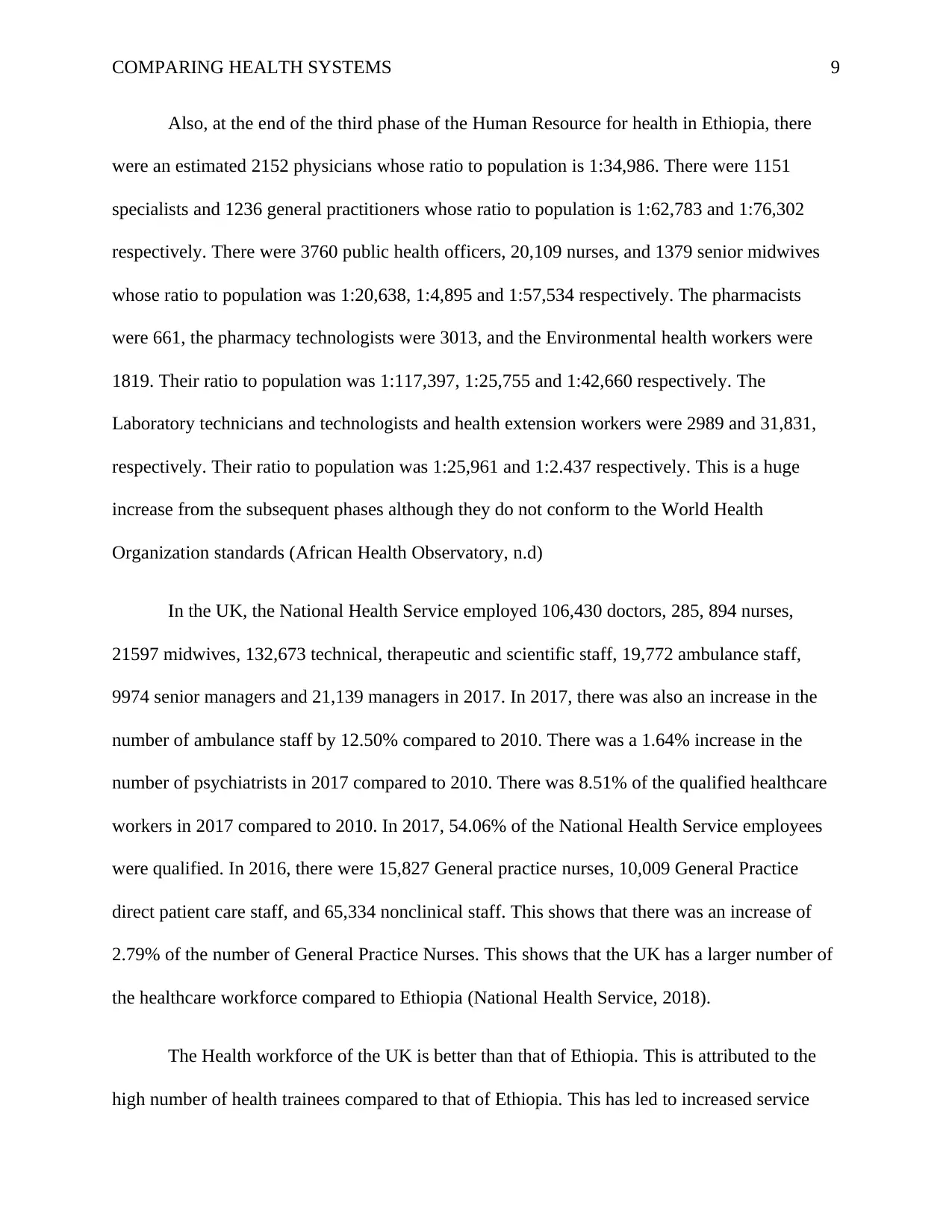
COMPARING HEALTH SYSTEMS 9
Also, at the end of the third phase of the Human Resource for health in Ethiopia, there
were an estimated 2152 physicians whose ratio to population is 1:34,986. There were 1151
specialists and 1236 general practitioners whose ratio to population is 1:62,783 and 1:76,302
respectively. There were 3760 public health officers, 20,109 nurses, and 1379 senior midwives
whose ratio to population was 1:20,638, 1:4,895 and 1:57,534 respectively. The pharmacists
were 661, the pharmacy technologists were 3013, and the Environmental health workers were
1819. Their ratio to population was 1:117,397, 1:25,755 and 1:42,660 respectively. The
Laboratory technicians and technologists and health extension workers were 2989 and 31,831,
respectively. Their ratio to population was 1:25,961 and 1:2.437 respectively. This is a huge
increase from the subsequent phases although they do not conform to the World Health
Organization standards (African Health Observatory, n.d)
In the UK, the National Health Service employed 106,430 doctors, 285, 894 nurses,
21597 midwives, 132,673 technical, therapeutic and scientific staff, 19,772 ambulance staff,
9974 senior managers and 21,139 managers in 2017. In 2017, there was also an increase in the
number of ambulance staff by 12.50% compared to 2010. There was a 1.64% increase in the
number of psychiatrists in 2017 compared to 2010. There was 8.51% of the qualified healthcare
workers in 2017 compared to 2010. In 2017, 54.06% of the National Health Service employees
were qualified. In 2016, there were 15,827 General practice nurses, 10,009 General Practice
direct patient care staff, and 65,334 nonclinical staff. This shows that there was an increase of
2.79% of the number of General Practice Nurses. This shows that the UK has a larger number of
the healthcare workforce compared to Ethiopia (National Health Service, 2018).
The Health workforce of the UK is better than that of Ethiopia. This is attributed to the
high number of health trainees compared to that of Ethiopia. This has led to increased service
Also, at the end of the third phase of the Human Resource for health in Ethiopia, there
were an estimated 2152 physicians whose ratio to population is 1:34,986. There were 1151
specialists and 1236 general practitioners whose ratio to population is 1:62,783 and 1:76,302
respectively. There were 3760 public health officers, 20,109 nurses, and 1379 senior midwives
whose ratio to population was 1:20,638, 1:4,895 and 1:57,534 respectively. The pharmacists
were 661, the pharmacy technologists were 3013, and the Environmental health workers were
1819. Their ratio to population was 1:117,397, 1:25,755 and 1:42,660 respectively. The
Laboratory technicians and technologists and health extension workers were 2989 and 31,831,
respectively. Their ratio to population was 1:25,961 and 1:2.437 respectively. This is a huge
increase from the subsequent phases although they do not conform to the World Health
Organization standards (African Health Observatory, n.d)
In the UK, the National Health Service employed 106,430 doctors, 285, 894 nurses,
21597 midwives, 132,673 technical, therapeutic and scientific staff, 19,772 ambulance staff,
9974 senior managers and 21,139 managers in 2017. In 2017, there was also an increase in the
number of ambulance staff by 12.50% compared to 2010. There was a 1.64% increase in the
number of psychiatrists in 2017 compared to 2010. There was 8.51% of the qualified healthcare
workers in 2017 compared to 2010. In 2017, 54.06% of the National Health Service employees
were qualified. In 2016, there were 15,827 General practice nurses, 10,009 General Practice
direct patient care staff, and 65,334 nonclinical staff. This shows that there was an increase of
2.79% of the number of General Practice Nurses. This shows that the UK has a larger number of
the healthcare workforce compared to Ethiopia (National Health Service, 2018).
The Health workforce of the UK is better than that of Ethiopia. This is attributed to the
high number of health trainees compared to that of Ethiopia. This has led to increased service
⊘ This is a preview!⊘
Do you want full access?
Subscribe today to unlock all pages.

Trusted by 1+ million students worldwide
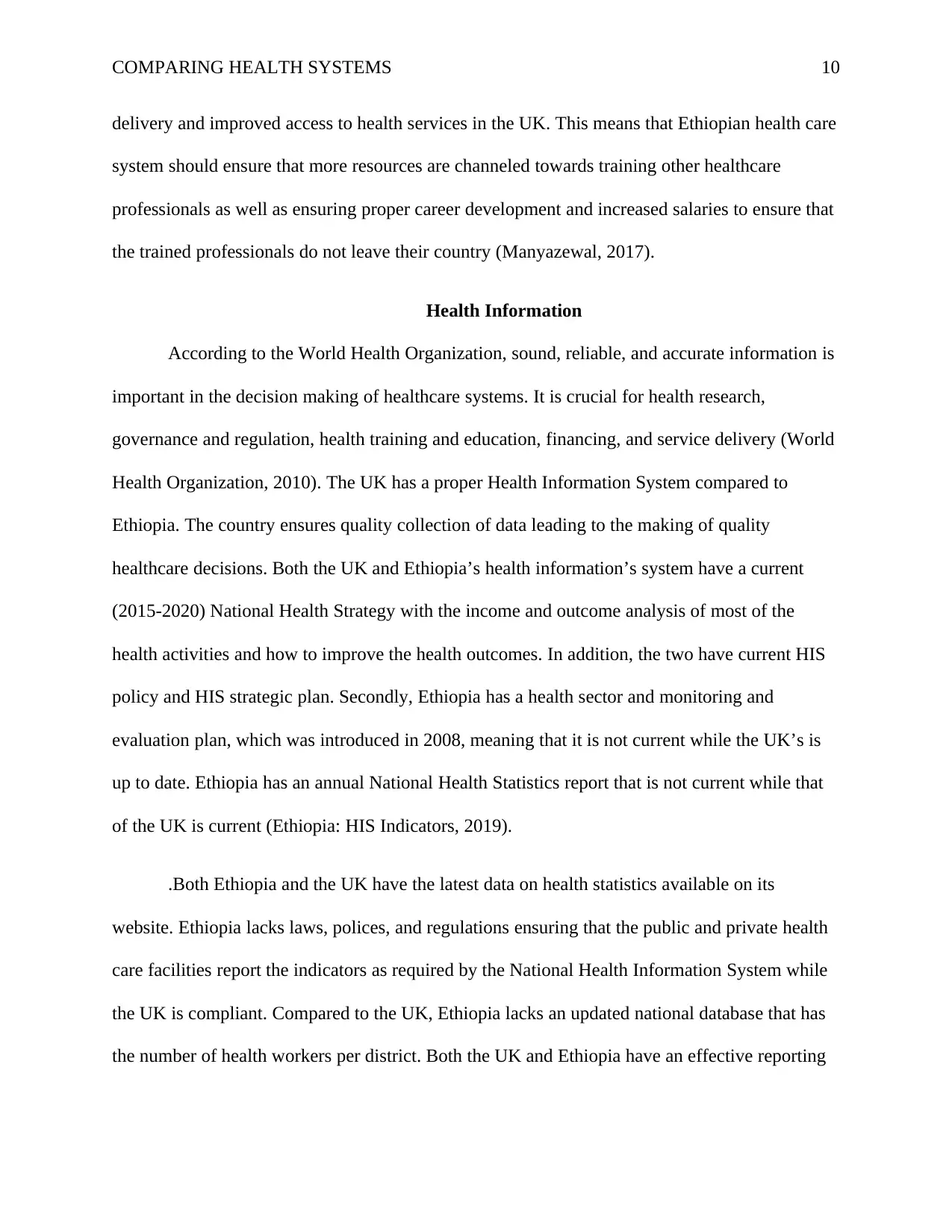
COMPARING HEALTH SYSTEMS 10
delivery and improved access to health services in the UK. This means that Ethiopian health care
system should ensure that more resources are channeled towards training other healthcare
professionals as well as ensuring proper career development and increased salaries to ensure that
the trained professionals do not leave their country (Manyazewal, 2017).
Health Information
According to the World Health Organization, sound, reliable, and accurate information is
important in the decision making of healthcare systems. It is crucial for health research,
governance and regulation, health training and education, financing, and service delivery (World
Health Organization, 2010). The UK has a proper Health Information System compared to
Ethiopia. The country ensures quality collection of data leading to the making of quality
healthcare decisions. Both the UK and Ethiopia’s health information’s system have a current
(2015-2020) National Health Strategy with the income and outcome analysis of most of the
health activities and how to improve the health outcomes. In addition, the two have current HIS
policy and HIS strategic plan. Secondly, Ethiopia has a health sector and monitoring and
evaluation plan, which was introduced in 2008, meaning that it is not current while the UK’s is
up to date. Ethiopia has an annual National Health Statistics report that is not current while that
of the UK is current (Ethiopia: HIS Indicators, 2019).
.Both Ethiopia and the UK have the latest data on health statistics available on its
website. Ethiopia lacks laws, polices, and regulations ensuring that the public and private health
care facilities report the indicators as required by the National Health Information System while
the UK is compliant. Compared to the UK, Ethiopia lacks an updated national database that has
the number of health workers per district. Both the UK and Ethiopia have an effective reporting
delivery and improved access to health services in the UK. This means that Ethiopian health care
system should ensure that more resources are channeled towards training other healthcare
professionals as well as ensuring proper career development and increased salaries to ensure that
the trained professionals do not leave their country (Manyazewal, 2017).
Health Information
According to the World Health Organization, sound, reliable, and accurate information is
important in the decision making of healthcare systems. It is crucial for health research,
governance and regulation, health training and education, financing, and service delivery (World
Health Organization, 2010). The UK has a proper Health Information System compared to
Ethiopia. The country ensures quality collection of data leading to the making of quality
healthcare decisions. Both the UK and Ethiopia’s health information’s system have a current
(2015-2020) National Health Strategy with the income and outcome analysis of most of the
health activities and how to improve the health outcomes. In addition, the two have current HIS
policy and HIS strategic plan. Secondly, Ethiopia has a health sector and monitoring and
evaluation plan, which was introduced in 2008, meaning that it is not current while the UK’s is
up to date. Ethiopia has an annual National Health Statistics report that is not current while that
of the UK is current (Ethiopia: HIS Indicators, 2019).
.Both Ethiopia and the UK have the latest data on health statistics available on its
website. Ethiopia lacks laws, polices, and regulations ensuring that the public and private health
care facilities report the indicators as required by the National Health Information System while
the UK is compliant. Compared to the UK, Ethiopia lacks an updated national database that has
the number of health workers per district. Both the UK and Ethiopia have an effective reporting
Paraphrase This Document
Need a fresh take? Get an instant paraphrase of this document with our AI Paraphraser

COMPARING HEALTH SYSTEMS 11
on disease surveillance that was last updated in 2018 with timeliness of 84.7% from the health
facilities (Cylus et al., n.d; Ethiopia: HIS Indicators, 2019).
Compared to the UK, Ethiopia lacks annual data on the availability of medicines and
other products in both the private and public health facilities. Both Ethiopia and the UK have the
procedures for verifying the completeness, accuracy, and timelines of data collected. Compared
to the UK, Ethiopia lacks a clear record of institutional deliveries present per district (Ethiopia:
HIS Indicators, 2019). The main challenge affecting Ethiopia's HMIS is lack of enough finances.
Secondly, there is a lack of adequate human resources and hence adversely affecting service
delivery (The world health report 2000, 2013). Thirdly, the country has paid less attention to the
supervisory and data quality assurance support. Lastly, it has failed to adopt new information
technology (Ethiopia: HIS Indicators, 2019).
Essential Medicines
According to the World Health Organization, an effective healthcare system requires
equity in access to essential medical products such as technologies and vaccines,
technologies, and medical products. The medical products should also be of good quality,
should be safe, effective, and cost-effective (World Health Organization, 2010). Compared
to Ethiopia, the UK has increased access to critical medical products among people. This is
attributed to the fact that the healthcare systems are well funded by the government through
taxes. However, there is variation in access to a different type of medical products across
the UK. This is attributed to the fact that there is a high demand for value. The factors that
put pressure on the UK healthcare system regarding access to medical products include the
increase in the aging population and the chronic diseases. There is also a high pressure from
on disease surveillance that was last updated in 2018 with timeliness of 84.7% from the health
facilities (Cylus et al., n.d; Ethiopia: HIS Indicators, 2019).
Compared to the UK, Ethiopia lacks annual data on the availability of medicines and
other products in both the private and public health facilities. Both Ethiopia and the UK have the
procedures for verifying the completeness, accuracy, and timelines of data collected. Compared
to the UK, Ethiopia lacks a clear record of institutional deliveries present per district (Ethiopia:
HIS Indicators, 2019). The main challenge affecting Ethiopia's HMIS is lack of enough finances.
Secondly, there is a lack of adequate human resources and hence adversely affecting service
delivery (The world health report 2000, 2013). Thirdly, the country has paid less attention to the
supervisory and data quality assurance support. Lastly, it has failed to adopt new information
technology (Ethiopia: HIS Indicators, 2019).
Essential Medicines
According to the World Health Organization, an effective healthcare system requires
equity in access to essential medical products such as technologies and vaccines,
technologies, and medical products. The medical products should also be of good quality,
should be safe, effective, and cost-effective (World Health Organization, 2010). Compared
to Ethiopia, the UK has increased access to critical medical products among people. This is
attributed to the fact that the healthcare systems are well funded by the government through
taxes. However, there is variation in access to a different type of medical products across
the UK. This is attributed to the fact that there is a high demand for value. The factors that
put pressure on the UK healthcare system regarding access to medical products include the
increase in the aging population and the chronic diseases. There is also a high pressure from
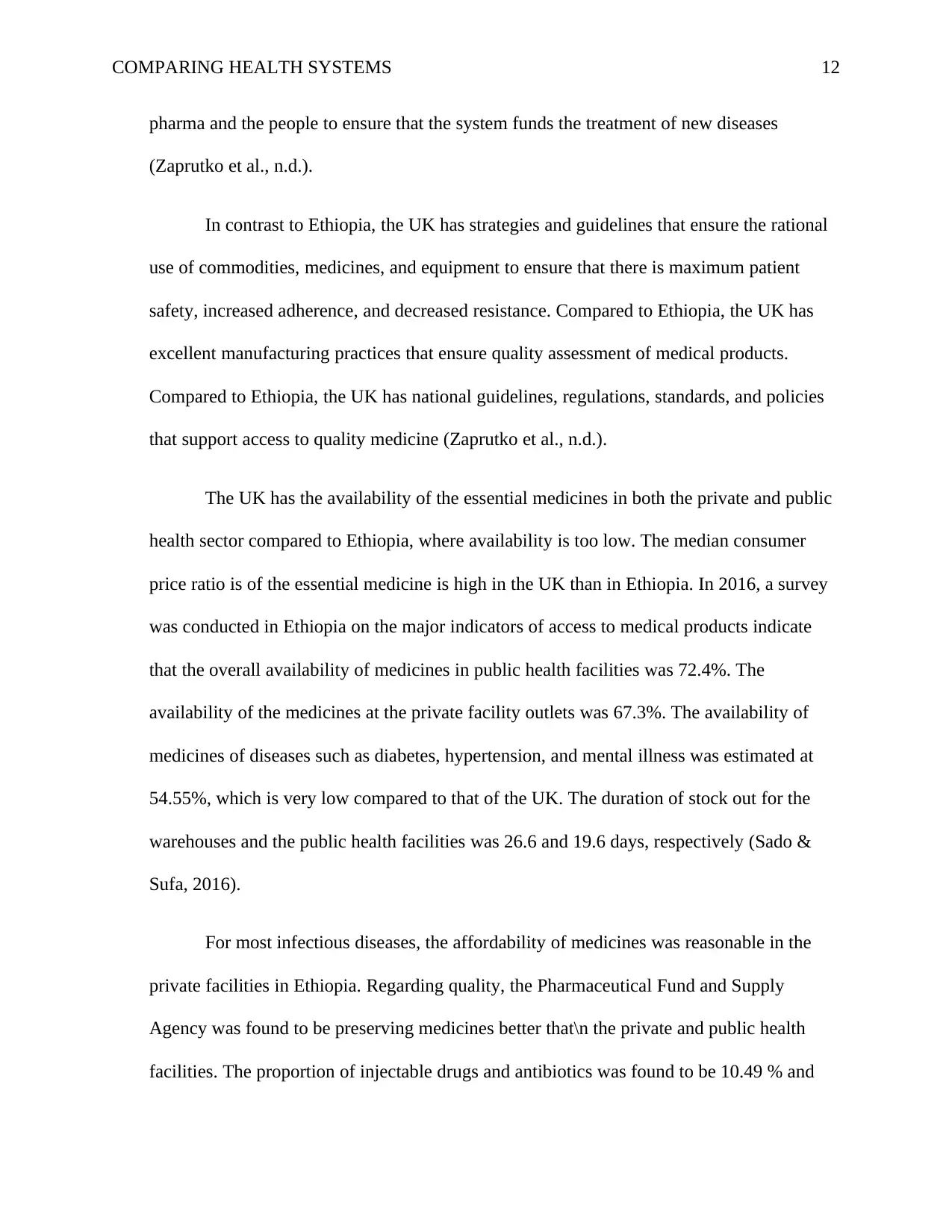
COMPARING HEALTH SYSTEMS 12
pharma and the people to ensure that the system funds the treatment of new diseases
(Zaprutko et al., n.d.).
In contrast to Ethiopia, the UK has strategies and guidelines that ensure the rational
use of commodities, medicines, and equipment to ensure that there is maximum patient
safety, increased adherence, and decreased resistance. Compared to Ethiopia, the UK has
excellent manufacturing practices that ensure quality assessment of medical products.
Compared to Ethiopia, the UK has national guidelines, regulations, standards, and policies
that support access to quality medicine (Zaprutko et al., n.d.).
The UK has the availability of the essential medicines in both the private and public
health sector compared to Ethiopia, where availability is too low. The median consumer
price ratio is of the essential medicine is high in the UK than in Ethiopia. In 2016, a survey
was conducted in Ethiopia on the major indicators of access to medical products indicate
that the overall availability of medicines in public health facilities was 72.4%. The
availability of the medicines at the private facility outlets was 67.3%. The availability of
medicines of diseases such as diabetes, hypertension, and mental illness was estimated at
54.55%, which is very low compared to that of the UK. The duration of stock out for the
warehouses and the public health facilities was 26.6 and 19.6 days, respectively (Sado &
Sufa, 2016).
For most infectious diseases, the affordability of medicines was reasonable in the
private facilities in Ethiopia. Regarding quality, the Pharmaceutical Fund and Supply
Agency was found to be preserving medicines better that\n the private and public health
facilities. The proportion of injectable drugs and antibiotics was found to be 10.49 % and
pharma and the people to ensure that the system funds the treatment of new diseases
(Zaprutko et al., n.d.).
In contrast to Ethiopia, the UK has strategies and guidelines that ensure the rational
use of commodities, medicines, and equipment to ensure that there is maximum patient
safety, increased adherence, and decreased resistance. Compared to Ethiopia, the UK has
excellent manufacturing practices that ensure quality assessment of medical products.
Compared to Ethiopia, the UK has national guidelines, regulations, standards, and policies
that support access to quality medicine (Zaprutko et al., n.d.).
The UK has the availability of the essential medicines in both the private and public
health sector compared to Ethiopia, where availability is too low. The median consumer
price ratio is of the essential medicine is high in the UK than in Ethiopia. In 2016, a survey
was conducted in Ethiopia on the major indicators of access to medical products indicate
that the overall availability of medicines in public health facilities was 72.4%. The
availability of the medicines at the private facility outlets was 67.3%. The availability of
medicines of diseases such as diabetes, hypertension, and mental illness was estimated at
54.55%, which is very low compared to that of the UK. The duration of stock out for the
warehouses and the public health facilities was 26.6 and 19.6 days, respectively (Sado &
Sufa, 2016).
For most infectious diseases, the affordability of medicines was reasonable in the
private facilities in Ethiopia. Regarding quality, the Pharmaceutical Fund and Supply
Agency was found to be preserving medicines better that\n the private and public health
facilities. The proportion of injectable drugs and antibiotics was found to be 10.49 % and
⊘ This is a preview!⊘
Do you want full access?
Subscribe today to unlock all pages.

Trusted by 1+ million students worldwide
1 out of 20
Related Documents
Your All-in-One AI-Powered Toolkit for Academic Success.
+13062052269
info@desklib.com
Available 24*7 on WhatsApp / Email
![[object Object]](/_next/static/media/star-bottom.7253800d.svg)
Unlock your academic potential
Copyright © 2020–2025 A2Z Services. All Rights Reserved. Developed and managed by ZUCOL.





